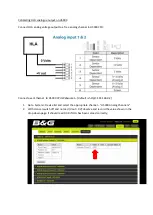
PLC API
TS5066
15
Version: 1.0
Identification of beat effects
In the ideal case of times only differing through drift, the occurrence of Δm≠1 would indicate a step change.
Due to the jitter of the cycle times around their nominal value, these cases predominantly occur around the
beat, causing the step change to be broadened into a transition zone. The width of this zone depends on the
magnitude of the clock jitter and on the absolute phase difference. Due to the width of the transition, it has to
be identified through a condition that is different from Δm≠1. At discontinuities, deviations from Δm=1 cause
the difference between sender and received cycles to increase. A difference that is constant over several
(
stTimeSyncParameters.iEndOfTransitionLimit
) cycles is used for identifying the occurrence of a beat. This
means that a step change can only be identified a certain number of cycles after its occurrence, which is
significant for determining the corrections.
The phase difference between the computers is determined through the number of clock cycles of the
receiver between two beats. This value can be used for correcting the beat effects.
Corrections
Figure 3 shows the cycle index of the sent information as a function of the received cycle index for case
Δm=2 at the discontinuity. The beat effects cause the gradient of the curve to deviate from the ideal value of
1. In order to avoid step changes, a corrected cycle index can be calculated (dotted line) such that the beat
effects are compensated during the time between the step changes. The result is a corrected cycle index on
the receiver side that deviates slightly from the transmitted value, but is equidistant and shows no step
changes.
Fig. 9: Figure 3: Received (continuous line) and corrected (dashed line) cycle index. The discontinuities with
Δm=2 are indicated by circles.
Since discontinuities can only be detected after the event as described above, the correction calculated with
the current drift can also only be applied with a delay. In order to avoid discontinuities of the corrected cycle
index even in the event of strong differences in clock times, the drift used for the correction is gradually
adjusted between the old valued and the new value once a discontinuity has been identified.
Another option for limiting the effects of strong changes in phase differences is non-uniform correction of
beat effects, which means a stronger correction is applied after a discontinuity than just before the expected
occurrence of the next discontinuity. If the time between two step changes becomes shorter, the correction is
largely completed, and only minor additional corrections will be required. Further information can be found in
the description of the
.
Correction time
The correction time can be determined from the difference between the corrected and the received cycle
index through multiplication with the cycle time. The correction time specifies the time shift required for the
information currently being read, in order to enable equidistant interpretation without step changes. If the
temporal variation of the value to be corrected is known, it can be extrapolated accordingly. For the cycle
index the interrelationship is simple (+1 per cycle time), for extrapolation of axis information such as position
and velocity, the velocity and acceleration have to be known (see documentation for function blocks
).
Initialisation phase
For calculating the corrections, at least two beat effects must have occurred, in order to be able to calculate
a drift. The so-called time mode is available for compensating fluctuations and step changes even before
these two beat effects have occurred. In this mode (outputs
bStartUp
=TRUE and
bSynced
=FALSE) the
corrected cycle index is incremented by 1 during each cycle, thus compensating step changes in the
received cycle index. After a discontinuity has been identified (the time of occurrence of which is not yet
foreseeable), the difference is compensated during the course of several cycles
(
stTimeSyncParameters.iTimeModeBlendingCycles
). Once the required number of beats
Summary of Contents for TS5066
Page 1: ...Manual EN TS5066 TwinCAT 2 PLC Remote Synchronisation 2021 10 13 Version 1 0 ...
Page 2: ......
Page 4: ...Table of contents TS5066 4 Version 1 0 ...
Page 30: ......
















































